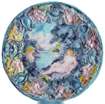 |

|
Diana at her Bath |
|
 |
Sassu’s interest in ceramics dates to the late 1930s, when he came into contact with Tullio
Mazzotti’s workshops in Albisola and the group of
artists, including Farfa, who gravitated around them. His first experiments in this
technique date to that period. But his most
significant work, quantitatively and qualitatively, dates to after World War II, when he
settled for a long period, until the early 1960s, in the Ligurian town. At that time he
worked in a climate of fervent exchange with many other artists captured by the same
passion: Fontana and Agenore Fabbri,
first of all, but also the old Chiarista painter Angelo Del Bon, the young Milanese
exponents of the Nucleare movement Roberto Crippa, Enrico Baj, and Sergio Dangelo, the
northern Abstract Expressionists of the Cobra group (Asger Jorn, Karel Appel, and
Guillaume Corneille), the Cuban Surrealist Wilfredo Lam. |

